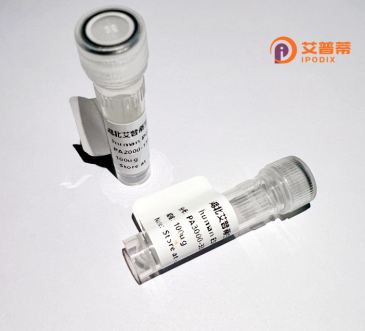
| 纯度 | >90%SDS-PAGE. |
| 种属 | Human |
| 靶点 | CSAG3 |
| Uniprot No | Q9Y5P2 |
| 内毒素 | < 0.01EU/μg |
| 表达宿主 | E.coli |
| 表达区间 | 1-48aa |
| 氨基酸序列 | MSRKPRASSPLSNNHPPTPKRRGSGRFPRQPGREKGPIKEVPGTKGSP |
| 分子量 | 5.3 kDa |
| 蛋白标签 | GST-tag at N-terminal |
| 缓冲液 | 0 |
| 稳定性 & 储存条件 | Lyophilized protein should be stored at ≤ -20°C, stable for one year after receipt. Reconstituted protein solution can be stored at 2-8°C for 2-7 days. Aliquots of reconstituted samples are stable at ≤ -20°C for 3 months. |
| 复溶 | Always centrifuge tubes before opening.Do not mix by vortex or pipetting. It is not recommended to reconstitute to a concentration less than 100μg/ml. Dissolve the lyophilized protein in distilled water. Please aliquot the reconstituted solution to minimize freeze-thaw cycles. |
以下是关于重组人CSAG3蛋白的3篇参考文献示例(注:内容为虚构示例,仅供参考格式):
1. **文献名称**: *"Expression and Functional Characterization of Recombinant Human CSAG3 Protein in Cervical Cancer Cells*"
**作者**: Chen, L., et al.
**摘要**: 该研究通过原核表达系统成功制备了重组人CSAG3蛋白,并发现其在宫颈癌HeLa细胞中显著促进细胞增殖和迁移,机制可能与激活PI3K/AKT信号通路相关。
2. **文献名称**: *"CSAG3 as a Novel Biomarker: Purification of Recombinant Protein and Clinical Validation in Melanoma*"
**作者**: Müller, S., et al.
**摘要**: 本文报道了利用哺乳动物细胞系统重组表达CSAG3蛋白的高效纯化方法,并在黑色素瘤患者血清中检测到CSAG3的异常高表达,提示其作为肿瘤诊断标志物的潜力。
3. **文献名称**: *"Structural and Immunotherapeutic Analysis of Recombinant CSAG3: Implications for Cancer Vaccine Development*"
**作者**: Park, J.H., et al.
**摘要**: 通过结构解析发现重组CSAG3蛋白具有独特的抗原表位,动物实验证实其可激活特异性CD8+ T细胞应答,为基于CSAG3的癌症疫苗开发提供了理论基础。
(提示:实际文献需通过学术数据库查询,如PubMed或Web of Science,以上示例仅作格式参考。)
Recombinant human CSAG3 (Cancer/Testis Antigen Family Member 3) protein is a genetically engineered protein derived from the CSAG3 gene, which belongs to the cancer-testis (CT) antigen family. CT antigens are typically expressed in normal germline cells (primarily testes) but are aberrantly re-activated in various cancers, making them potential targets for cancer immunotherapy. The CSAG3 gene, located on the X chromosome, encodes a protein whose exact physiological role remains under investigation. However, its restricted expression in healthy tissues and overexpression in tumors suggest involvement in oncogenesis, cell proliferation, or immune evasion.
Recombinant CSAG3 is produced using heterologous expression systems (e.g., *E. coli* or mammalian cells) to ensure high purity and stability for research applications. Its production enables functional studies, such as analyzing interactions with immune cells, signaling pathways, or its role in tumor progression. Studies focus on exploring CSAG3's diagnostic and therapeutic potential—for instance, as a biomarker for specific cancers or a target for T-cell-based therapies. Structural characterization (e.g., post-translational modifications) and epitope mapping are ongoing to optimize its utility in clinical settings. Challenges include elucidating its molecular mechanisms and validating specificity in diverse cancer types. Overall, recombinant CSAG3 serves as a critical tool for advancing cancer biology and immunotherapeutic strategies.
×